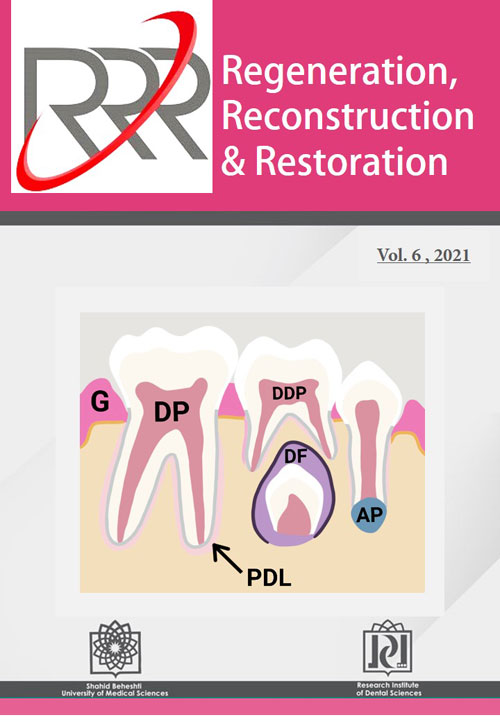فهرست مطالب
Journal of Regeneration, Reconstruction and Restoration
Volume:3 Issue: 2, Summer 2018
- تاریخ انتشار: 1398/05/15
- تعداد عناوین: 3
-
-
Page 1Introduction
The aim of this study is to figure out how effective 980 nm diode laser is to reduce post surgical complications of impacted mandibular third molar tooth.
Material and MethodsThis randomized, double-blind clinical trial is performed on 30 patients who were randomly divided into two groups. In the case group, the diode laser was irradiated in two regions extraorally and four regions intraorally. Each region received a thirty-second irradiation with a wavelength of 980 nm and power of 500 mW, immediately after operation while the control group was exposed to the inactive irradiation of the same laser. The severity of pain, swellings, mouth opening, and patients' quality of life were evaluated. Data is analyzed by Independent two-sample t test, Fisher´s exact test and Two-way repeated measures analysis of variance.
ResultsOn the seventh day of study, the case group received both a significantly lower mean score of functional limitation, physical discomfort domains and a lower total score of Oral Health Impact Profile 14-questionnaire rather than the control group (Respectively P=0.011, P=0.027, p=0.032). However, the mean score related to pain, swellings, trismus and other domains of OHIP-14 wasn't much varied between the two groups throughout the study period. (P>0.05)
ConclusionAlthough irradiating PBM after impacted mandibular third molar surgery isn't effective to reduce side effects such as pain, swellings and trismus it seems to improve the quality of life related to functional limitation and physical discomfort.
Keywords: Photobiomodulation, complications, third molar, surgery -
Page 2Purpose
To systematically review the diagnosis of osteoporosis by means of panoramic radiography.
Materials and methodsAn electronic search was performed in PubMed and Cochrane databases limited to English articles published from the year 1990 until August 2012. Studies were selected based on inclusion and exclusion criteria. The indices in the panoramic radiograph and their normal values, as well as specificity and sensitivity of them in the diagnosis of osteoporosis, were evaluated.
ResultsAmong the 2460 articles, 40 were included. Although most of these studies indicated correspondence between radiographic indices and the reduction in bone density, some found no correlation between panoramic radiographic indices and osteoporosis. Mandibular cortical width (MCW) and mandibular cortical index (MCI) were the most studied indices in the diagnosis of osteoporosis.
ConclusionsConsidering the results of this study, panoramic radiography can be beneficial in the diagnosis of the reduction in bone density and osteoporosis in a dental office setting.
Keywords: Osteoporosis, mandible, panoramic radiography, postmenopausal women -
Page 3Introduction
Advancing the dysplastic maxilla in cleft palate patients is a challenging issue. This study aimed to report a case of maxillary advancement in a cleft palate patient by distraction osteogenesis technique.
Materials and methodsA 21 year old woman with the chief complaint of retruded maxilla was planned to be treated by distraction method. An external craniofacial distraction device was used in a total different way to advance the hypoplastic maxilla. In the second section of the study a review table of advancing techniques in such cases was designed and presented.
ResultsThe amount of maxillary advancement was 10 mm horizontally and 5 mm inferiorly. The distraction procedure gave the ability of moving the maxilla in two directions. The tooth show was improved and paranasal area and A point were advanced to help in gaining a straight profile. The remained discrepancy was corrected by mandibular setback procedure.
ConclusionsDistraction osteogenesis may be a reliable treatment plan in advancing hypoplastic midface in cleft palate patients. The results of this method may be more sufficient than routine orthognathic surgery.
Keywords: Cleft palate, Distraction osteogenesis, Maxilla


